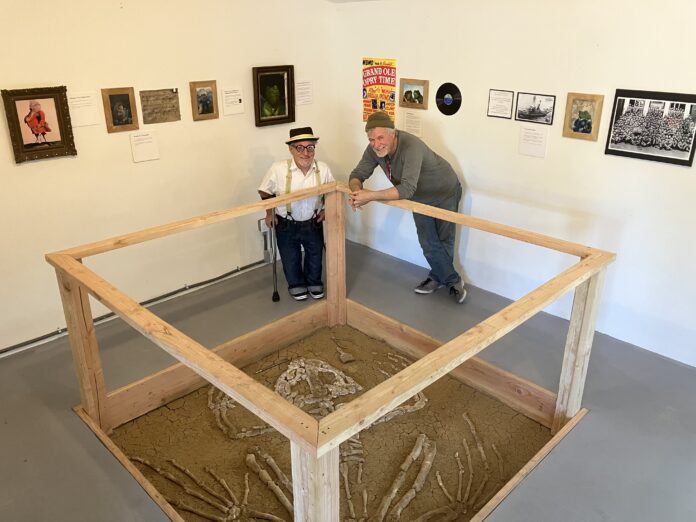Last Thursday, I drove to Sebastopol to track down an emerging mystery.
Word was spreading on the social media platforms TikTok and NextDoor that two locals had made a shocking find. While fixing up the floor of Highway 116’s Rabbit Hole Art Gallery, Mark Grieve, a long-time artist, claimed to have found the skeleton of a massive, ancient frog.
At the door of the gallery, Grieve and collaborator Sam Roloff beckoned me inside, getting down to business before I could pull out my notepad and pen.
“This is this unbelievable find that we came across,” Grieve said, after I’d armed myself with the stenographic tools of my trade. “We found this and realized that we had to do extensive subjective research in order to verify our claim.”
Surrounded by a modest but meaningful-looking fence of 2’ x 4’s, lay the subject of growing intrigue: the seven-foot fossil, partially uncovered and still surrounded by a few tools. Grieve and Roloff have dubbed the discovery the Megla Bufo Giganticus or Mega Toad for short.
On the walls around the gallery, rebranded as the Rabbit Hole Research Institute in honor of the “unbelievable” find, hung a few dozen frog-themed pieces.
Gesturing around the room, Grieve said, “Through our extensive subjective research, all non-billable, we found the rest of this evidence. Each one of these is supporting the claim that Megla Bufo Giganticus has lived with us for millenia.”
Leading me towards the front door, Grieve arrived at a row of stones with illustrations on them, which he called “petroglyphs.” Above them, two maps hung. The first, an overhead view of the Sebastopol area, showed the locations where Grieve claimed to have found the rocks; the second showed the Bufo Constellation, which Grieve says only appears once every 15 and a half years.
“It’s incredible, right?” Grieve said of the two maps, which both show an array of dots making remarkably similar frog shapes.
Returning his focus to the stones, Grieve acknowledged that the Research Institute, powered as it is by volunteers, has yet to pay for carbon dating. However, he added, “we know they’re old because they’re rocks.”
Other artifacts range from a music score for Antonio Montovini’s “The Lillies in the Pond,” a piece which allegedly features the lowest musical note ever written, to a bottle of TOAD perfume, which the Research Institute claims is a lesser-known follow-up to Jean Patou’s wildly popular JOY fragrance first released in 1930.
A few minutes into the tour, Grieve, not an actor by training, dropped out of character. “I don’t want to run you through every piece… we’d be here for a while,” he conceded.
Instead of an authentic find, Grieve admitted, the Rabbit Hole’s current show is an elaborate ruse, with the Mega Toad as its centerpiece.
“The skeleton is supporting the jokes, and the jokes are supporting the skeleton,” Grieve said.
A long-time North Bay artist, Grieve struck up a friendship with Roloff a few years ago at a party. When Roloff offered him space at the gallery, Grieve took the opportunity to make good on a long-time dream of discovering a fossil. From there, Grieve, Roloff and a few other collaborators filled out the story, spending the past few months “finding” the numerous artifacts that cover the studio’s walls.
After opening the Research Institute’s show, the collaborators shared videos to YouTube and TikTok announcing the “unbelievable” discovery.
The pair see the show as a commentary on the way truth and trust in the scientific method have rapidly decayed in recent years. In short, it is an artful send-up for the “do-your-own-research” crowd—those who have ventured down one of the rabbit holes which proliferate online.
“Basically it’s about this whole making fun of the subjective truths that a lot of people have on YouTube and all that,” Roloff said.
“Everyone is doing their, quote, ‘research’ now… so that’s why we like the phrase ‘subjective research.’ Because you’re researching just whatever the hell you want to, when you want to, how you want to, and you can come to your own conclusions,” Grieve added.
Although at least one attendee seemed peeved to discover they had been subjected to an elaborate joke, most have taken it well, according to the collaborators.
“It’s really fun to read the comments on NextDoor,” Roloff said, referring to the social media site where neighborhood gossip often turns toxic. While some commenters wanted to believe in a world with larger-than-life frogs, others were eager to call BS, saying “that’s fake as f**k.”
“And yet, it’s just a frog, so no one’s really getting upset. It’s not politics, you know. Everyone can just play with this concept,” Roloff said.
“I don’t think we’re playing into people’s vulnerabilities with this show… we’re having fun with the idea that we can play with an illusion… to bring a little joy,” Grieve added.
Following a going away party on Nov. 18, the collaborators aim to take the show on the road. If their unbelievable luck continues, they might re-discover the Mega Toad, or a distant relative, after jack-hammering the floor of New York’s Guggenheim Museum or repairing a third-floor gallery in San Francisco.
The Megla Bufo Giganticus/Mega Toad and accompanying artifacts will be on display until Saturday, Nov. 18, when the Research Institute, located at 2836 Gravenstein Highway South in Sebastopol, will host a farewell celebration from 3-10pm. More information is available at samroloff.com and markgrieve.com. Grieve can be contacted at gr**********@***il.com.











